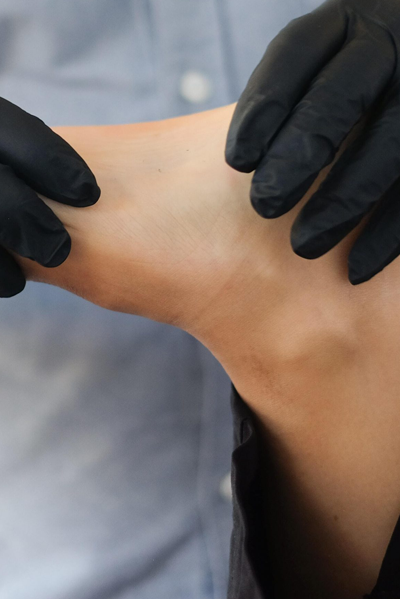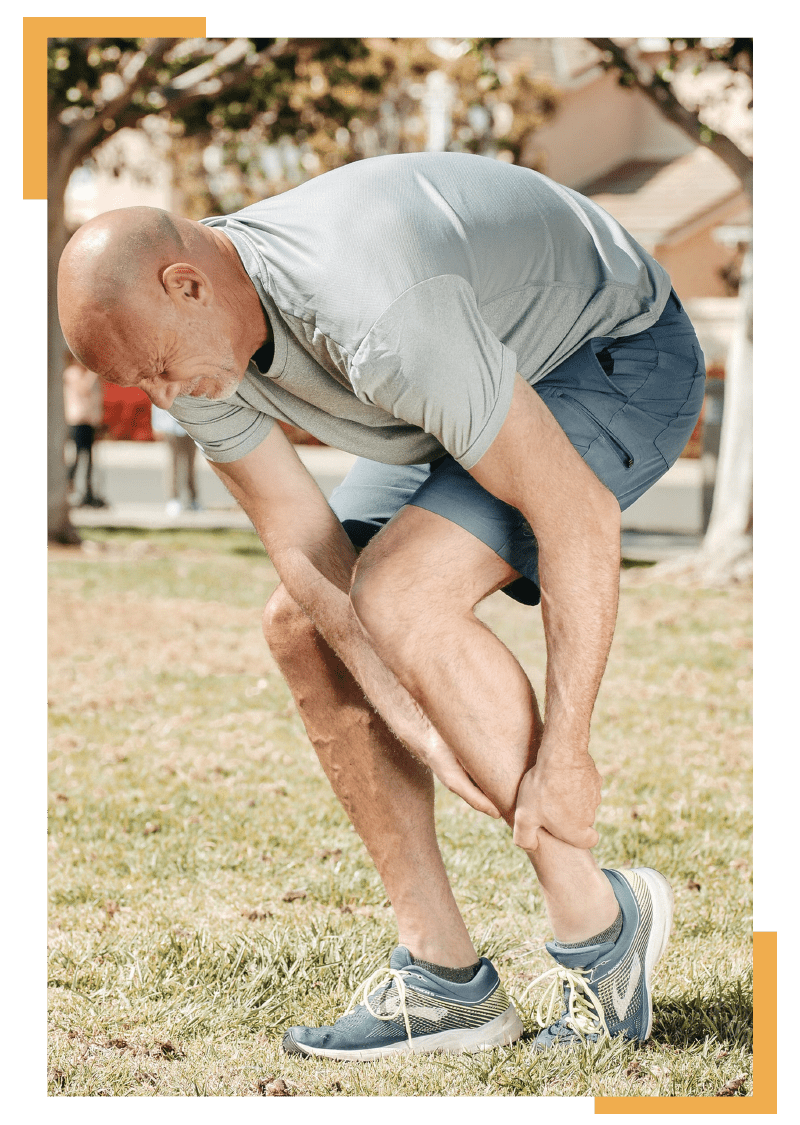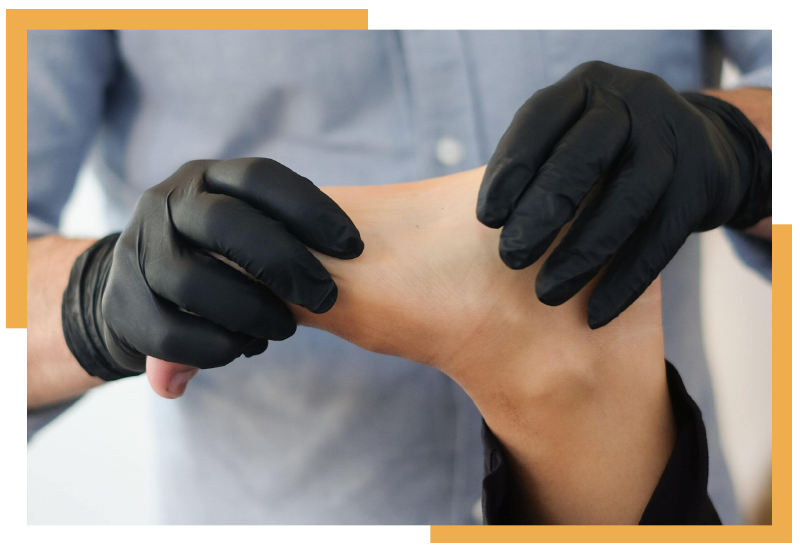Ankle and Foot Injury Therapy
If you get an injury to your foot or ankle, you can seek physical therapy services to alleviate the pain and improve your strength. You can contact us and start your healing journey.

Sprained Ankle Physical Therapy
Pain or discomfort around the ankle or foot from stress and fractures can hinder daily activities. They also affect mobility, which can limit your independence. Ankle and foot therapy helps with stretching exercises and strengthening muscles preventing further injury.
Sprained Ankle Physical Therapy
The most common types of ankle and foot injury include:
- Achilles tendon
- Ankle sprain
- Exertional compartment syndrome
- Plantar fasciitis
Sprained Ankle Physical Therapy
We also provide rehabilitation services if you go through surgery to correct underlying ankle and foot conditions. Our therapists understand the delicate balance between doing too much and not doing enough to meet the treatment goals. We create a good plan to ensure you are recovering safely and effectively.

Achilles Tendon Injuries
Achilles is the largest tendon in the body, stretching from the bone of the heels to the calf muscles. You can feel this tendon; it is the stretchy tough band of tissue at the back of your heel just above the heel. The Achilles tendon allows you to stand on your toes as you walk, run, or jump. Though it is strong, the Achilles tendon is prone to injuries because it has a limited blood supply.
Treatments and Management
Rest is a good remedy for most injuries experienced on the tendon. Compression, ice, elevation, and tying can also help reduce the swelling. You can also use over-the-counter medication to manage pain. If it is severe, you can require prescription medications to manage the pain. Wearing custom-made orthotics, heel lifts, or braces and splints are also helpful with injuries.
Additionally, ankle and foot physical therapy can aid in dealing with the condition. At our clinic, we offer modified exercises, which include stretches to help you manage injuries to the tendon; in cases where the tendon ruptures, surgery helps reattach it. Foot immobilization and physical therapy helps in recovery after the surgery.
The Most common Achilles injuries are:
Achilles Tendon Tear
You can experience tiny tears, microtears, or large tears that cause swelling, pain, and impaired movement. The condition can occur when performing an activity or gradually over time.
Achilles Tendon Rupture
The tendon can rupture, making a popping sound. Pain in the lower leg follows, and it also swells. Surgery and long-term ankle immobilization can be necessary to repair the tendon.
Achilles Tendinitis
Inflammation at the end of the Achilles tendon can occur gradually from frequent activities such as running or walking. It leads to stiffness and pain at the back of the heel.
Achilles Peritendonitis
It is similar to Achilles tendinitis. However, the inflammation occurs in the area with the tissue surrounding the tendon about two inches or more above the heel.
Achilles or Heel (calcaneal) Bursitis
Wearing low heels can irritate the bursa, a fluid sac that cushions the heel. Feeling pain in the back of the heel when wearing shoes can indicate this condition.
Achilles Tendinosis
Aging or overuse can cause gradual thickening of the Achilles tendon. Despite the tendon becoming thick, it can become prone to injuries or a rupture.
Patient Wellbeing is Our Primary Concern
Contact us for customized ankle or foot injury therapy services.

Exertional Compartment Syndrome
Compartment syndrome occurs because of a dangerous buildup of pressure in the muscles. This pressure causes blood flow to decrease, reducing oxygen and nourishment from reaching the muscles and nerve cells. The condition is excruciating, and it is mostly exercise-induced.
The causes of exertional compartment syndrome are not fully known. As you exercise, muscles expand. When you have this condition, the fascia or the tissue encasing the muscles fails to expand, causing pain and pressure.
Symptoms
- Tightness sensation on the affected limb
- Burning, aching, and cramping on the affected limb
- Tingling and numbness
- Foot drop in extreme cases when the leg is affected
- Swelling and bulging from muscle hernia
Treatment and Management
You need to stop activities aggravating the condition before starting on other treatment options. The doctor can suggest that you take pain medication initially and engage in physical therapy to manage the injury. Our physical therapists advise on the best technique to manage the condition.
Non-operative methods often do not last long in this condition, and surgery is required. The most effective procedure is known as a fasciotomy. It entails the incision of the tissue casing (fascia) of the affected muscles relieving pressure. The incision can be small, which reduces the recovery time. You can go through physical and occupational therapy to help with the recovery process after surgery.

Plantar Fasciitis
It is a condition describing pain at the bottom of the heel. The thick, web-like ligament connecting the heel to the front of the foot is known as the plantar fascia. It supports the arch of the foot as you walk and also acts as a shock absorber.
It is a common complication as it is prone to wearing and tearing. Applying too much pressure on the foot can lead to tearing or damage to the ligament. When it is inflamed, it causes pain and stiffness to the heel.
Symptoms
You can experience a stabbing pain near the heel at the bottom of the foot. The pain can be worse when you wake up, although standing for long can trigger the pain.
Treatment and Management
You can take pain medication to deal with the pain—therapies such as using orthotics to offer support and distribute pressure to the foot evenly. Physical therapy for managing plantar fasciitis conditions involves helpful exercises that strengthen the muscles. At our ankle and foot therapy clinic, we assess the damage and formulate a program to help with foot support.
We can also advise you on the use of night splints, which stretch your calf and the arch of your foot when you are sleeping. The splints keep the plantar fascia and Achilles tendon in a lengthened position as you sleep. It promotes stretching. If you are looking for ankle and foot physical therapy near me, we have a personalized exercise regime.
A doctor can also inject steroids, providing relief. It is not advisable to get multiple shots because they can weaken the plantar fascia and cause a rupture. A doctor can also use extracorporeal shock wave therapy, directing sound waves to the injured area, stimulating healing. In cases where there is severe pain, surgery can be the best option.
Ankle Sprain
The ankle joint connects your lower leg with your foot. In the joint, three ligaments keep your ankle bones in place. When you roll or twist your ankle awkwardly, a sprain can occur. It affects these ligaments after movement beyond their normal range of motion. Mostly, this condition occurs on the outside of the ankle.
Symptoms
- Pain when you shift weight on the affected foot
- Bruising
- Swelling
- Tender ankle
- Ankle instability
- Hearing a ‘pop’ sound when the injury occurs
- Restricted motion range
Causes
- A fall causing a twist on the ankle
- Pivoting or jumping and landing awkwardly
- Exercising or walking on uneven surfaces
- Someone landing on your foot during an activity
Treatment and Management
You can perform self-care activities such as resting, using ice, tying a compression to stop the swelling. Elevating the foot can also keep it from swelling. Using over-the-counter medicine helps with pain management.
It is also good to use assistive devices such as crutches to prevent pain as you walk. Physicians can also use elastic bands, ankle support, or sports tape depending on the condition’s severity. Physical therapy for ankle sprains helps in strengthening the muscles when the swelling has reduced. We create controlled exercises to aid in recovery. We also train on balance and stability, which prevents recurrent injuries.
In rare cases, doctors can resort to surgery to help repair ligaments. The surgery can also reconstruct a damaged ligament by using surrounding tissue or tendon.

How Physical Therapy Helps with Ankle and Foot Injury
As you can see, many conditions affect the ankle and the foot. However, physical therapy for foot pain gives one a chance to recover more quickly. Whether you have a sprained ankle or need physical therapy for ankle strengthening, at OneRehab, we have unmatched PT to help you on this journey. A physical therapist will help you to:
Reduce Swelling and Pain
Therapists can apply heat or ice to the foot to reduce pain and swelling. Additionally, they help you adjust and modify your daily activities giving the foot or ankle time to heal. They can also use:
- Ultrasound,
- Electrical stimulation,
- Hands-on therapy,
- Taping or
- Specific massage to reduce the pain
Motion Improvement
Physical therapists can choose specific techniques and activities to help restore normal foot and ankle motion. They can begin with passive motions where the therapist moves the foot gently while monitoring your progress. Once you become comfortable and movement improves, you can actively do the exercises.
Range of motion exercises can include:
- Tracing the alphabet with your toes increasing the ability to move it in all directions. You can repeat the exercise several times.
- You can also sit on a chair, press your foot firmly on the ground and keep it in that position as you move the knee side to side.
- Towel curls are also ideal for improving motion. To do this, sit and place your foot on the floor while scrunching a towel with your toes towards you. Also, use your toes to push the towel away from you. As your progress improves, you can add a weight on the other end of the towel to make it challenging.
Improving Balance
When the foot gets injured, it affects your balance. Physical therapy balance exercises for the ankle helps you to regain your balance. The PT can teach you several exercises which you can perform at home to improve your balance. These include:
- Standing only on the injured foot as you hold out your arms to the side and closing your eyes. At first, you may be unsteady; you can stand in the doorway so that you can use the door frame for support.
- Standing on the injured foot, cross your arms on the chest and open your eyes. Repeat the exercise several times as you hold each time for about 1 minute.
Improve Flexibility
When you go for sprained ankle physical therapy, the therapist also introduces stretching exercises to improve flexibility. They will first assess the foot or ankle to determine if you have tight muscles. If so, they can start to stretch them, which helps to increase the range of motion. Some stretching exercises include:
- Towel stretch where you sit with your legs straight and place a rolled towel under the foot. Then, hold the towel at both ends and gently pulling towards you.
- Calf stretch: Another exercise you can perform is calf stretch. It involves standing and facing the wall with your hands placed on it but at eye level. Then, putting the affected leg a step behind the other leg and keep the back heel on the floor as you bend your front knee until a stretch is felt on the back leg. Hold that stretch for about 30 seconds and repeat the exercise 4 times.
Strength Improvement
After an injury, muscles can become weak, affecting your ability to recover. Therefore, physical therapy foot exercises are ideal in helping you regain your strength. These exercises help you heal and steadily increase your strength which prevents re-injury. For these exercises, you may use cuff weights, weight lifting equipment, and stretch bands.
It’s advisable to talk to the therapist before using physical therapy ankle weights. You also need to know the correct timing to start these exercises after an injury. Experts normally advise exercises when you start to withstand the pain without it increasing or the foot or ankle swelling.
- Sit with your foot flat on the floor, pushing it outwards against a wall, furniture, or any immovable object. Once you feel the stretch, hold it for a few seconds.
- When seated, put your feet flat on the floor together. Hold for about 6 seconds when pressing the injured foot inward against the other one and relax.
- Placing the other foot's heel on the injured one, push down with the heel as the injured foot pushes upwards. Hold that position for 5 seconds and repeat after relaxing.
OneRehab
1761 International Pkwy Suite 135, Richardson, TX 75081, United States
Email Us
info@onerehab.com
Call Us
972 845 7875
Working Hours
M - F 7:00 AM – 7:00 PM
Sat 8:00 AM – 2:00 PM



